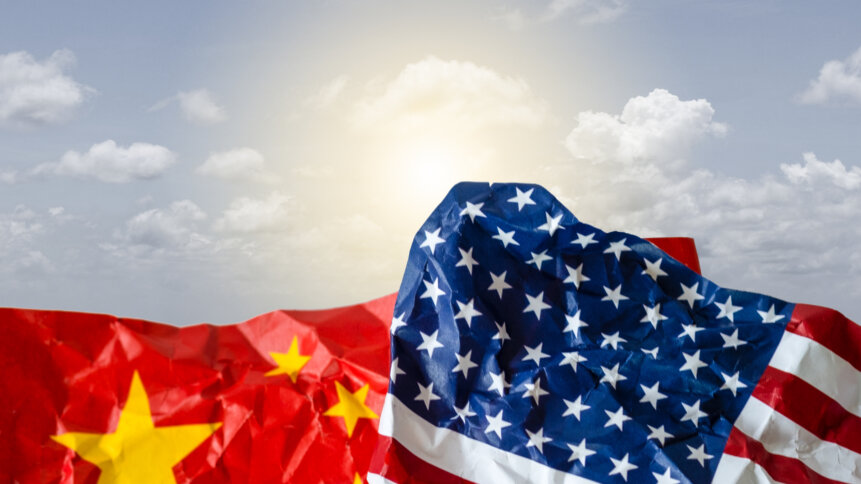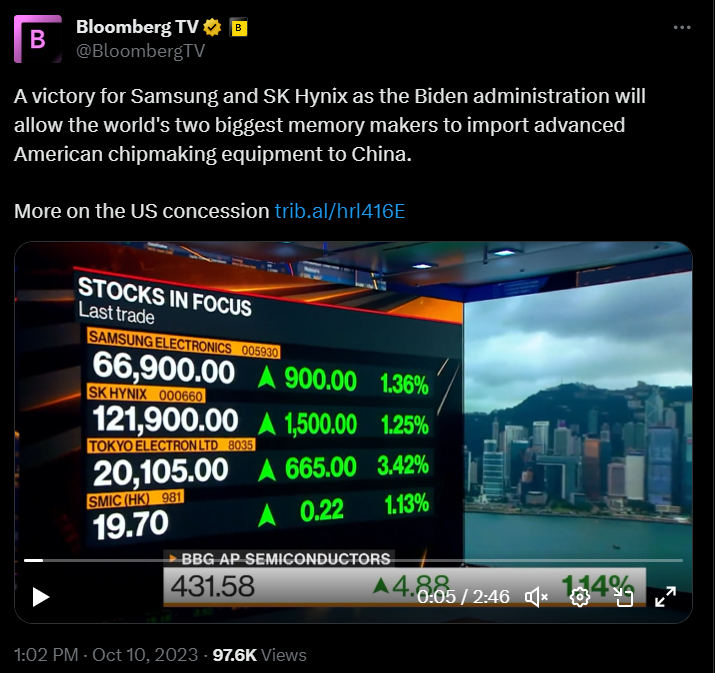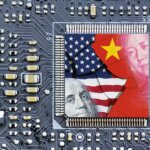US-China: tightening the screws with export controls while granting leeway to some

- The US seems aims to close loopholes in its export controls against China.
- Samsung and SK Hynix have obtained approval to maintain equipment shipments to their facilities in China.
- TSMC is anticipating a comparable “permanent” authorization.
The US has been consistently enforcing export controls against China for years. Companies like Huawei and SMIC, the country’s largest chip manufacturer, were among the first to feel the bite of US controls. That took a turn in October 2022, when the US government decided to opt for a more comprehensive set of measures aimed at crippling the entire Chinese semiconductor industry.
The measures implemented on October 7, 2022, are of such historical importance that US think tank the Center for Strategic and International Studies (CSIS) has likened their impact on the geopolitics of 2022 to that of the February 24 event, when Russia invaded Ukraine. The US goal was clear — to curb China’s technological progress, this time in absolute terms.
The rationale behind the move by Washington is rooted in the belief that China’s military should not have access to advanced AI chips and supercomputers. As such, restrictions were set in place to thwart China’s ability to create weapons of mass destruction and autonomous weaponry. The export control specifically addresses advanced chips and the machinery used for chip manufacturing.
The immediate impact was that US giants making AI chips — Nvidia and AMD — have since been unable to export their best chips, the A100 and H100, to China. That should, in theory, have been a tough blow for China, especially since AI has been experiencing global hype since the release of ChatGPT in November 2022.
But that hasn’t been the case.
To begin with, before announcing the export controls on October 7, the US had unveiled the CHIPS and Science Act. The law came with guardrails designed to limit the extent to which companies receiving CHIPS Act incentives could expand their semiconductor investments.
Commerce Secretary Gina Raimondo said it would “help ensure that malign actors do not have access to cutting-edge technology that can be used against America and our allies.” Those guardrails inevitably augmented the stringent export controls on semiconductor equipment to China and the January 2023 US-Japan-Netherlands pact limiting chipmaking tool exports.

US Commerce Secretary Gina Raimondo testifies during the Senate Commerce, Science, and Transportation hearing to examine CHIPS and science implementation and oversight, on Capitol Hill in Washington, DC, on October 4, 2023. (Photo by SAUL LOEB / AFP)
Did the US export controls fail to contain China?
But the US cannot have been satisfied with its measures because, reportedly, there are loopholes in the export controls, which the Biden administration plans to address as the ruling passes its one-year mark. “The Biden administration is seeking to strengthen controls on selling graphics chips for AI applications and advanced chipmaking equipment to Chinese firms,” according to a recent Bloomberg report.
The updated rule, said to be in the final stages of review, will include enhanced scrutiny for Chinese companies attempting to bypass export restrictions by rerouting shipments through other countries. Additionally, Chinese chip design companies will be included in a trade restriction list, requiring foreign manufacturers to obtain a US license before fulfilling orders for these firms.
The US officials warned China recently to expect rules restricting shipments of semiconductor equipment and advanced AI chips to be updated this month. Further confirming the reports was a regulation titled Export Controls to Semiconductor Manufacturing Items, Entity List Modifications, posted on the Office of Management and Budget (OMB) website last week.
“Export control rules are generally not posted by OMB until an agreement is reached between the Departments of State, Defense, Commerce and Energy on their content. An anticipated companion rule updating restrictions on exports of high-end chips used for artificial intelligence has yet to be posted by the government,” Reuters’ report indicated.
A source told Reuters that the Biden administration is aiming to publish both rules simultaneously, possibly this week. What has been irking the US is that since the October 2022 ruling was announced, China has expedited its investments in developing its domestic capabilities.
For example, despite ongoing US sanctions, Huawei introduced a new 5G-capable smartphone last month. What surprised industry observers was that the phone’s 5G processor was manufactured by the domestic company Semiconductor Manufacturing International Corporation (SMIC). This component exceeded the expectations of many experts regarding the company’s production capabilities.
In short, the efforts to close the loophole show how the Biden administration is struggling to cut China off from top AI technology and how difficult it is to plug every gap in export controls. Although shipping those AI chips to mainland China would violate US law, experts have pointed out the significant challenges the US faces in regulating these transactions.
They highlight the fact that employees based in China could access the chips held at foreign subsidiaries remotely and still comply with legal requirements.
Samsung and SK Hynix granted indefinite waivers, with TSMC expecting the same
Last week, South Korea’s Yonhap News Agency reported that its local chip giants Samsung and SK Hynix will be allowed to ship US semiconductor manufacturing equipment to their China factories indefinitely without separate approvals. Choi Sang-mok, Seoul’s senior presidential secretary for economic affairs, told reporters the US government has already notified the two companies of its decision, which takes effect immediately.

Samsung and SK Hynix get licenses to import high-end equpiment to China. Source: X
Previously, Samsung and SK Hynix, alongside Taiwan Semiconductor Manufacturing Co (TSMC), the world’s largest contract producer of computer chips, received waivers when Washington imposed sweeping export restrictions to prevent China from getting advanced semiconductor technology.
The one-year waivers from the US would have expired this month.
This recent development alleviates the worries of Samsung and SK Hynix regarding their chip manufacturing operations in China, which depend to some extent on equipment from the US.
Moreover, according to a Fitch report, China is a key manufacturing hub, accounting for 40% of Samsung’s total flash memory chips (NAND) production capability.
It also accounts for 40%-50% of SK Hynix’s dynamic random access memory (DRAM) chips and 20% of its NAND capacity.
TSMC has also applied for–and expects to receive–permanent authorization from Washington to export US chipmaking equipment to its China-based factory.
“TSMC has been authorized to continue (to) operate in Nanjing, and we are currently in the process of applying for a permanent authorization for our operations in China,” it told AFP in an email Friday.
According to the Taiwanese chip giant, the Bureau of Industry and Security advised the firm to apply for a “Validated End-User (VEU)” authorization. This “would serve as a permanent authorization,” TSMC said, adding that it had never had to apply for it in the past. “We expect to receive a permanent authorization through the VEU process.”










